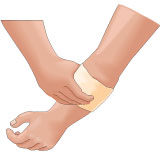First Aid: Bleeding and Arrow Wounds

Transporting an injured hunter to professional medical care as quickly as possible is imperative. However, what happens before the victim is treated by medical professionals can be critical to his or her survival and future quality of life. The NBEF strongly recommends that you take a certified first-aid course.
Bleeding
Pressure, applied firmly and directly, is the best control of serious bleeding anywhere on the body. Pressure closes blood vessels and forms a barrier, allowing blood to clot around the wound.
- Use a thick, soft, clean pad to apply firm pressure directly on the bleeding wound.
- Covering the wound and applying pressure is most important, even if you have to use your hand. Try to avoid contaminating the wound with dirt, grass, or other foreign matter.
- Once applied, try not to remove the pressure bandage. Removal will reopen the wound and cause bleeding to start again.
- If the bandage becomes soaked with blood, put another layer over the top rather than peeling off the existing layer.
- When direct pressure cannot control severe bleeding, tourniquets are now advised for the treatment of life-threatening, catastrophic bleeding.
Arrow Wound
A deep wound in the chest or abdomen calls for quick action, especially if an artery or vein has been cut by a razor-sharp broadhead.
- If possible, apply a pressure bandage to the damaged vessel or the wound.
- If the arrow remains in the victim, leave it there. The broadhead itself may provide the pressure needed to stop the bleeding from the wound and allow clotting to occur around it.
- Try to stabilize the arrow with adhesive tape or other material. Minimize movement of the shaft to avoid further injury from the broadhead.
- Give medical professionals a duplicate of the arrow embedded in the victim so that they see the size and shape to avoid injuring themselves as they treat the victim. A duplicate arrow also helps them determine if they have retrieved all of the broadhead from the victim’s body.